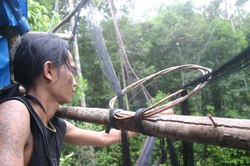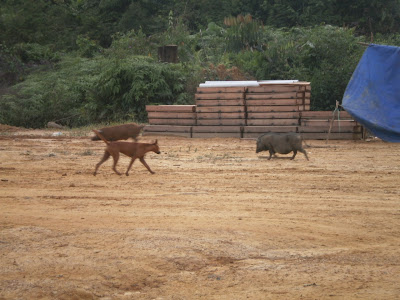- a Wildlife Research Group, The Anatomy School, University of Cambridge, Downing Street, Cambridge CB2 3DY, UK
- b Orangutan Tropical Peatland Project, Centre for the International Cooperation in Sustainable Management of Tropical Peatlands, Universitas Palangka Raya, Palangka Raya 73112, Central Kalimantan, Indonesia
- c Wildlife Conservation Research Unit (WildCRU), Department of Zoology, Oxford University, Tubney, Abingdon Road, OX13 5QL, UK
- d Centre for the International Cooperation in Tropical Peatlands, Universitas Palangka Raya, Palangka Raya 73112, Central Kalimantan, Indonesia
- e Faculty of Forestry, Universitas Mulawarman, Samarinda 75117, East Kalimantan, Indonesia
- f Durrell Institute of Conservation and Ecology, School of Anthropology and Conservation, University of Kent, Canterbury CT2 7NR, UK
- g School of Biological & Chemical Sciences, Queen Mary University of London, Mile End Road, London E1 4NS, UK
- Received 3 January 2011. Revised 12 June 2011. Accepted 27 June 2011. Available online 22 July 2011.
Abstract
Widespread hunting of flying foxes has generated concern regarding population declines and the spread of emerging infectious diseases. To investigate the potential impacts of this trade, we conducted questionnaires in 45 settlements across 12 population centres within Central Kalimantan, Indonesia, a region previously identified as a hunting hotspot. By combining results from 63 hunter and 88 vendor interviews, we highlight two population centres (Palangka Raya and Buntok/Tamiang Layang) with higher hunting rates than other areas, which act as flying fox trading hubs. Flying fox populations were perceived to be declining province-wide: declines in captures and sales were reported by 81% of hunters and 60% of market vendors, who also reported availability as the key factor underlying temporal variations in trade. There was substantial risk of zoonotic disease transmission between bats, hunters and traders: the vast majority of respondents were unaware that flying foxes carry potentially fatal viruses, and so few people protected themselves from physical contact. Moreover, both hunters and vendors were frequently bitten and the majority of bites drew blood. Most hunters (58%) also reported unintentional by-catches that included keystone bird species and slow lorises. The scale of hunting over Central Kalimantan represents a serious threat to the long-term viability of flying fox populations (and potentially those of other species), and could have serious public health implications. Reducing or eliminating hunting and trade would mitigate the risk of disease transmission, while maintaining the economic and ecosystem benefits that flying foxes provide, in terms of pollination and seed dispersal.
Highlights
► We used questionnaires to reveal impacts of flying fox trade in Indonesian Borneo. ► Flying fox populations were perceived to be declining province-wide. ► Hunters and traders highlighted two population centres acting as bat trading hubs. ► There was substantial risk of zoonotic disease transmission between bats, hunters and traders. ► By-catches included keystone bird species and slow lorises.
Keywords
- Pteropus vampyrus;
- Hunting;
- Emerging infectious disease;
- Wildlife trade;
- Henipavirus;
- Bat
Figures and tables from this article:
- Fig. 1. Map of main survey locations and geographical variation in flying fox trade intensity within Central Kalimantan, Indonesian Borneo. Abbreviations for place names follow those in Table 1. White circles indicate locations of market surveys and are weighted by trade intensity, based upon these surveys and hunting surveys conducted in villages within a few kilometres of these locations (see Sections and for details). The main potential transport routes on roads (red) and rivers (blue) are indicated. Central Kalimantan’s location in Borneo is shown in the inset (international borders emphasised) with dots illustrating Pteropus vampyus locality records updated from Struebig et al. (2010). Areas of peat-swamp forest (green) in both maps follow the SarVision LLC coverage; Langner et al., 2007. (For interpretation of the references to colour in this figure legend, the reader is referred to the web version of this article.).
- View Within Article
- Fig. 2. Proportion of hunter income obtained through trading in flying foxes around each large population centre. Hunters were asked to approximate the income into one of five categories, which were assigned scores for analytical purposes (1 = ⩽ 20%; 2 = 21–40%; 3 = 41–60%; 4 = 61–80%; 5 = 81–100%); error bars indicate 95% confidence intervals of the mean scores. Asterisks and lines connecting large population centres indicate significant differences between mean scores (Dunn’s post hoc, α = 0.05). Abbreviations for place names follow those in Table 1.
- View Within Article
- Fig. 3. Potential risk from zoonotic disease transmission amongst flying fox hunters and market vendors. Respondents were asked four questions regarding disease risk. Values for “yes” in the question on disease awareness include responses that there was a risk if bats were handled (3% vendors and 0% hunters) and if bitten and the bite drew blood (2% vendors and 3% hunters). Responses for the question on whether bites drew blood are limited to respondents who reported being bitten at least once.
















































